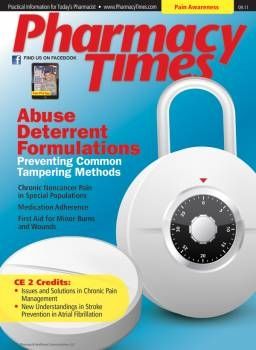Publication
Article
Pharmacy Times
Opioids in an Era of Shifting Attitudes
Author(s):
Financial support for the article was provided by

INTRODUCTION
In recent decades, opioid utilization in the United States has increased considerably. A number of factors are believed to have contributed to this trend, one of which was the publication of several studies in respected journals in the 1990s suggesting that opioids, in addition to successfully treating acute pain, could be of benefit to selected patients with chronic noncancer pain, which was considered undertreated at the time.1-3
Although comprising just 4.6% of the world’s population, Americans now consume 80% of the global opioid supply, including 99% of the world’s hydrocodone, and more than 66% of the world’s illegal drugs. From a population perspective, sales of commonly used opioid prescription drugs (by amount of active ingredient dispensed) have risen 149% from 1997 to 2007; per person, the increase was 402%.1
THE IMPACT OF INCREASED UTILIZATION
In conjunction with escalating opioid use, there have been corresponding increases in fraud and abuse, resulting in higher societal costs as well as increased mortality. In addition, there are numerous medicolegal, ethical, and legal concerns, as well as other patient-, physician-, and system-related issues, all of which require resolution.4,5
One example of a patient-related issue is the inability to clearly define an anatomic source of one’s pain; not all patients are able to put their finger on the spot from which their pain emanates. Comorbid conditions, such as psychiatric disturbances, can also complicate diagnosis and treatment, as can past or current substance abuse issues.
Other, perhaps more basic, patient-related issues exist that may prove more difficult to fix, such as opioid abusers’ ability to manipulate and deceive. In several high-profile prosecutions of physicians prescribing opioids, prosecutors have claimed that the prescribers should have known that the addicts they were treating were feigning pain just to obtain prescription drugs. A recent article reviewed studies in which physicians were asked to identify standardized patients (individuals trained to present a history and physical examination findings consistent with a disease or condition). Six studies were included; at least 2 of these studies pertained to pain. Physicians identified the standardized patients approximately 10% of the time, demonstrating that deception is very difficult to detect. Some real patients were also misidentified as standardized patients.6
Physicians, particularly those in primary care, typically lack training in the appropriate evaluation of pain and pain management.5,7 Physicians also fear creating drug addicts, but at the same time may face pharmaceutical industry pressure to prescribe medications while having few practical clinical practice guidelines to rely upon for credible information. Legal and regulatory ramifications further complicate pain management, as do controversies over the effectiveness of opioid therapy in these patient populations.5
Physicians may also be noncompliant with clinical practice guidelines. A recent study of physicians’ compliance with guidelines for the initial treatment of acute low back pain and sciatica determined that a majority of primary care physicians are noncompliant with treatment guidelines. These physicians trended toward overly intensive initial treatment, based on the belief that such treatment was within guidelines. More experienced physicians were found to have less knowledge, adhere less to guidelines, and have poorer patient outcomes.7 Further evidence from a systematic review suggests that opioid prescribing may be higher than might be expected from clinical guidelines.8
Some assistance could be implemented to minimize clinician discomfort and facilitate appropriate treatment of patients with pain, including better continuing medical education programs and more pre-graduate training. In clinical practice, improved physician communication with pharmacists and pharmacy systems can aid in identifying and quantifying utilization of opioids from all prescribing sources. Also, coordinated multidisciplinary care for patients with pain, with adequate reimbursement for this care, and physician access to state-based opioid prescription systems, would further support these efforts.5
ARE OPIOIDS FULFILLING THEIR PROMISE?
Despite the fact that opioids have been in use for thousands of years, as stated earlier, it has only been within the past 2 decades that usage has spiked, despite the challenging climate in which clinicians must practice pain management. It is estimated that of patients visiting pain centers and receiving treatment for chronic pain, 90% are taking opioids.9 Opioids function through various mechanisms at multiple points along the pain pathway; however, they are not without side effects. The most common side effects of opioids are constipation and nausea; other side effects of opioids include sedation, dizziness, physical dependence, tolerance, and respiratory depression (potentially fatal).10,11 Potential adverse effects of long-term use include hormonal and immune system effects, tolerance, and hyperalgesia.9-11 Opioids are addictive, and may be misused and/or diverted.
Though well-intentioned in design, some of the most recently developed opioid analgesic formulations are easily transformed into popular drugs of abuse by addicts who are extremely resourceful at procuring illicit drugs. One such popular sustained-release opioid formulation indicated for acute pain was designed to avoid the peaks and valleys associated with abuse. When used as directed, the formulation is effective in treating moderate to severe pain; however, abusers soon discovered that the tablet could be crushed, the powder extracted, and either “formulated” for injection or inhaled intranasally to achieve the rapid, powerful opioid onset effect that abusers find desirable. Similarly, oral methadone is not associated with euphoric or pleasurable effects; however, tablets have a very high street value because their powder can be melted and formulated into an injectable drug that is associated with an intense, prolonged “high.”2 The risks associated with opioid use must be weighed against the evidence-based benefits on an individualized basis.
ARE OPIOID EQUIVALENTS AVAILABLE?
Given the subjective nature of pain, there may never be a definitive answer to this question; however, much research has been conducted into the formulation of opioid equivalents. Short-term studies have been identified in which noncontrolled analgesics have demonstrated equivalence and/or comparable performance to oxycodone, acetaminophen-codeine, and morphine.12-14
Kampe et al assessed the clinical equivalence of controlled-release oxycodone 20 mg and controlled-release tramadol 200 mg after breast cancer surgery. Between treatment groups there were no significant differences between patients’ perception of postoperative pain, adverse events, or satisfaction.12 Friday et al compared acetaminophen-codeine against ibuprofen in acute pain in children with extremity injuries and found similar performance in analgesic effectiveness. Both treatments were well tolerated with few treatment failures and few adverse effects.13 Vergnion et al compared the efficacy of tramadol and morphine administered intravenously to trauma patients for pain management in the prehospital setting. They determined that in this trauma setting, tramadol is an acceptable alternative to morphine.14
William Yarnall, RPh, CCP has stated that he has no conflicts of interest.
REFERENCES
- Manchikanti L, Fellows B, Ailinani H, Pampati V. Therapeutic use, abuse, and nonmedical use of opioids: a ten-year perspective. Pain Physician. 2010;13:401-435.
- Mitra S, Sinatra RS. Perioperative management of acute pain in the opioid-dependent patient. Anesthesiology. 2004;101:212-227.
- Pletcher MJ, Kertesz SG, Kohn MA, Gonzales R. Trends in opioid prescribing by race/ethnicity for patients seeking care in US emergency departments. J Am Med Assoc. 2008;299:70-78.
- Benyamin RM, Datta S, Falco FJ. A perfect storm in interventional pain management: regulated, but unbalanced. Pain Physician. 2010;13:109-116.
- Olsen Y, Daumit GL. Opioid prescribing for chronic nonmalignant pain in primary care: challenges and solutions. Adv Psychosom Med. 2004;25:138-150.
- Jung B, Reidenberg MM. Physicians being deceived. Pain Med. 2007;8:433-437.
- Webster BS, Courtney TK, Huang YH, Matz S, Christiani DC. Physicians’ initial management of acute low back pain versus evidence-based guidelines: influence of sciatica. J Gen Intern Med. 2005;20:1132-1135.
- Somerville S, Hay E, Lewis M, et al. Content and outcome of usual primary care for back pain: a systematic review. Br J Gen Pract. 2008;58:790-797, i-vi.
- Trescot AM, Glaser SE, Hansen H, Benyamin R, Patel S, Manchikanti L. Effectiveness of opioids in the treatment of chronic non-cancer pain. Pain Physician. 2008;11:S181-S200.
- Benyamin R, Trescot AM, Datta S, et al. Opioid complications and side effects. Pain Physician. 2008:11(2 suppl):S105-S120.
- Ballantyne JC. Opioid analgesia: perspectives on right use and utility. Pain Physician. 2007;10:479-491.
- Kampe S, Wolter K, Warm M, Dagtekin O, Shaheen S, Landwehr S. Clinical equivalence of controlled-release oxycodone 20 mg and controlled-release tramadol 200 mg after surgery for breast cancer. Pharmacology. 2009;84:276-281.
- Friday JH, Kanegaye JT, McCaslin I, Zheng A, Harley JR. Ibuprofen provides analgesia equivalent to acetaminophencodeine in the treatment of acute pain in children with extremity injuries: a randomized clinical trial. Acad Emerg Med. 2009;16:711-716.
- Vergnion M, Degesves S, Garcet L, Magotteaux V. Tramadol, an alternative to morphine for treating posttraumatic pain in the prehospital situation. Anesth Analg. 2001;92:1543-1546.








